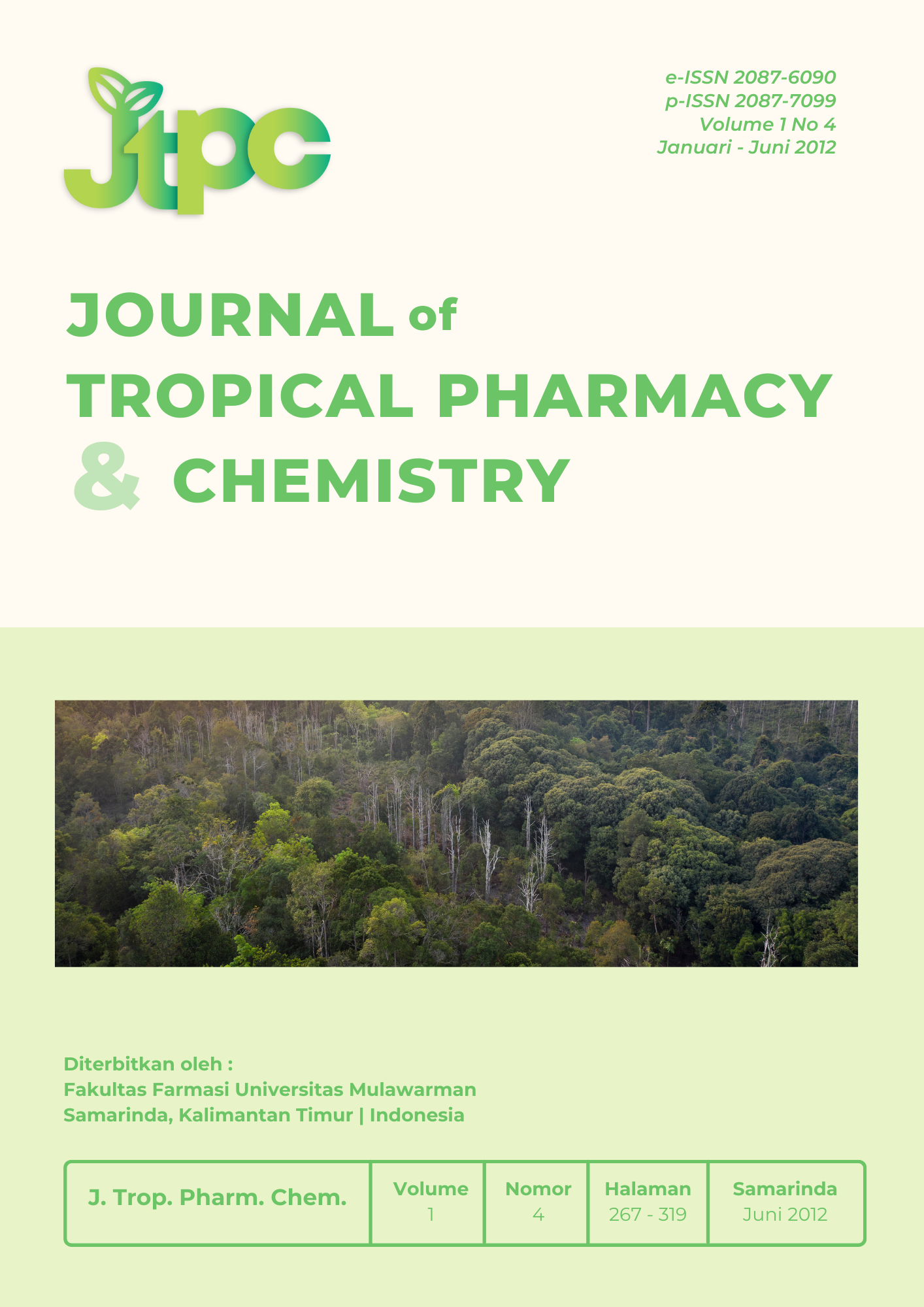Potensi Antimikroba Fraksi Aktif Ekstrak n-Heksan Daun Rami (B.virgata F.) Guill terhadap Beberapa Mikroba Uji
Keywords:
leaf B. virgata, antimicrobial, fraction soluble extracts of n-hexane, solid dilutionAbstract
This study aims to determine the potential antimicrobial activity of extracts soluble, insoluble n-hexane and fractions of n-hexane extract of leaves of B. virgata, some microbial testing with solid dilution method. Test material used was n-hexane-soluble extract (A) and hexane-insoluble (B), two extract was monitored by Thin Layer Chromatography method (TLC) chemical components, then tested its activity by solid dilution method. Test results of the antimicrobial activity of both types of extracts showed better activity than the methanol extract of soluble fraction of n-hexane and methanol extract of insoluble, because it can inhibit the growth of the bacterium E. coli, V. cholerae and S. thyposa, while the methanol extract of n-hexane soluble not only able to inhibit the bacteria V. cholerae, at a concentration of 1000 μg/ml medium. Fraction of methanol extract of n-hexane soluble (A) is then fractionated by the method of three funel system using eluent hexane: methanol: water (20: 6: 0.5), obtained three kinds of fractions ie fraction A, fraction B and fraction C. The antibacterial activity tes result of fraction A is active against bacteria V. chilerae, B fraction active against bacteria V.cholerae, S. thyposa and E. coli, and the active fractions of the yeast C.albicans C respectively each active at a concentration of 750 μg/ml medium.
Downloads
References
1.Ibrahim, A. 2011. Aktivitas Antimikroba Ektrak Daun Rami (Boehmeria virgata (Forst.) Guill terhadap Beberapa Mikroorganisme. Journal of Tropical Pharmacy and Chemistry. Vol. 1 No. 2 : 86-93)
2.Brink. M.; & Escobin. R.P. 2003.Plant Resources of South – East Asia.Fiber Plants. Backhuys Publishers. Leiden. 86 - 91.
3.Cheeke, P.R. 1987.Rabbit Feeding and Nutrition. Academic Press Inc. Orlando. 376 (online).
4.Djide, N.M. 2008.Analisis Mikrobiologi Farmasi. Jurusan Farmasi F.MIPA. Universitas Hasanuddin : Makassar. 295 - 301.
5.Gabbia, A. M.; Vegas, J.; Toledo, S.; Iora, A.; Fronza, L.; & Carlotto,S. 2002.Increasing Level of Ramie (Boehmeria nivea) Hay on the Diets of Fattening Rabbits. Journal Application Rabbit. Vol. 97: 105 - 900. (online).
6.Ganiswara, S. 1995.Farmakologi dan Terapi. Edisi IV. Bagian Farmakologi Fakultas Kedokteran Universitas Indonesia. Jakarta. 572 - 573.
7.Gritter, R.J.; Bobbit, J.M.; & Schwarting, A.E. 1991.Pengantar Kromatografi. Edisi II. Penerbit ITB. Bandung. 1, 14, 114 -115.
8.Hertiani, T. 2003.Uji In VitroPotensi Antimikroba Terhadap Staphylococcus aureus Eschericia coli, Shigella dysentriae dan Candida albicansdari Beberapa Tanaman Obat Tradisional Untuk Penyakit Infeksi. Jurnal Farmasi Indonesia Pharmacon. Volume 4 (2), Surakarta. 2003.
9.Jawetz, M.; & Adelbergs’s. 2001.Mikrobiologi Kedokteran. Terjemahan Staf Pengajar Bagian
Mikrobiologi Fakultas Kedokteran. Universitas Airlangga. Salemba Medika. Jakarta. 224 - 228.
10.Lin, C.C; Yen, M.H.; Lo, T.S.; & Lin, J.M. 1998.Evaluation of the Hepatoprotective and
Antioxidant Activity of Boehmeria nivea var. nivea and B. nivea var.
11.Mendes, A.A.; Funari, S.R.C.; Nunes, J.R.V.; & Spers, A. 1980.Increasing Levels of Rami Hay in Rations for Rabbits in Development. Journal Application Rabbit. Vol. 1 : 27 – 35 (online).
12.Olson, J. 2004.Belajar Mudah Farmakologi. Cetakan 1. EGC Penerbit Buku Kedokteran. Jakarta.
13.Syahrurrahman, A.; Chatim, A.; Subandrio, A.; Karuniawati, A.; Triyatni, R.M.; Utji, R.; & Sardjito, R. 1994.Mikrobiologi Kedokteran. Edisi Revisi. Binarupa Aksara. Jakarta. 7 - 10, 163.
14.Stahl, E. 1969.Thin Layer Chromatography. 2nd edition. Springer Verlag. Berlin. Heidelberg. New York. 650-654.
15.Strohl, W.; et al. 2001.Lippincott’s Illustrated Reviews: Microbiology. Lippincott Williams & Wilkins. A Walters Kluwer Company. Baltimore. Maryland. USA. 4




